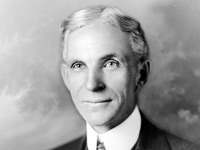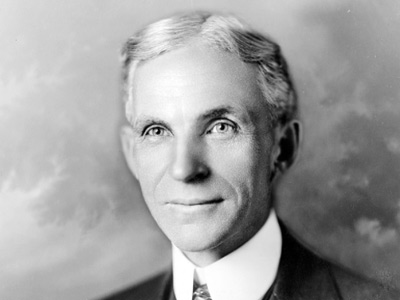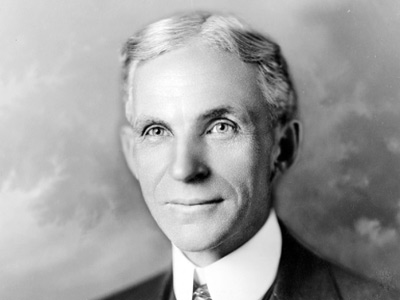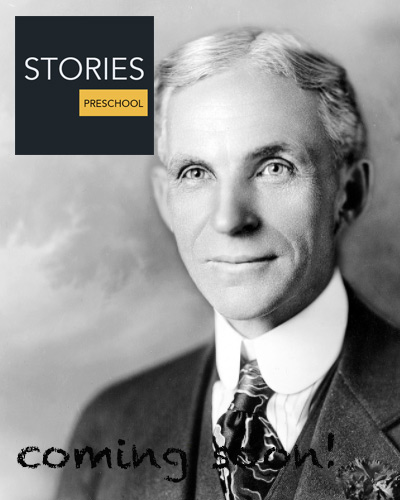Career
In 1891, Ford became an engineer with the Edison Illuminating Company of Detroit. After his promotion to Chief Engineer in 1893, he had enough time and money to devote attention to his personal experiments on gasoline engines. These experiments culminated in 1896 with the completion of a self-propelled vehicle which he named the Ford Quadricycle. He test-drove it on June 4. After various test drives, Ford brainstormed ways to improve the Quadricycle.
Also in 1896, Ford attended a meeting of Edison executives, where he was introduced to Thomas Edison. Edison approved of Ford's automobile experimentation. Encouraged by Edison, Ford designed and built a second vehicle, completing it in 1898. Backed by the capital of Detroit lumber baron William H. Murphy, Ford resigned from the Edison Company and founded the Detroit Automobile Company on August 5, 1899. However, the automobiles produced were of a lower quality and higher price than Ford wanted. Ultimately, the company was not successful and was dissolved in January 1901.
With the help of C. Harold Wills, Ford designed, built, and successfully raced a 26-horsepower automobile in October 1901. With this success, Murphy and other stockholders in the Detroit Automobile Company formed the Henry Ford Company on November 30, 1901, with Ford as chief engineer. In 1902, Murphy brought in Henry M. Leland as a consultant; Ford, in response, left the company bearing his name. With Ford gone, Murphy renamed the company the Cadillac Automobile Company.
Teaming up with former racing cyclist Tom Cooper, Ford also produced the 80+ horsepower racer "999" which Barney Oldfield was to drive to victory in a race in October 1902. Ford received the backing of an old acquaintance, Alexander Y. Malcomson, a Detroit-area coal dealer. They formed a partnership, "Ford and Malcomson, Ltd." to manufacture automobiles. Ford went to work designing an inexpensive automobile, and the duo leased a factory and contracted with a machine shop owned by John and Horace E. Dodge to supply over $160,000 in parts. Sales were slow, and a crisis arose when the Dodge brothers demanded payment for their first shipment.
Ford Motor Company
In response, Malcomson brought in another group of investors and convinced the Dodge Brothers to accept a portion of the new company. Ford and Malcomson was reincorporated as the Ford Motor Company on June 16, 1903, with $28,000 capital. The original investors included Ford and Malcomson, the Dodge brothers, Malcomson's uncle John S. Gray, Malcolmson's secretary James Couzens, and two of Malcomson's lawyers, John W. Anderson and Horace Rackham. Ford then demonstrated a newly designed car on the ice of Lake St. Clair, driving 1 mile (1.6 km) in 39.4 seconds and setting a new land speed record at 91.3 miles per hour (146.9 kilometres per hour). Convinced by this success, the race driver Barney Oldfield, who named this new Ford model "999" in honor of the fastest locomotive of the day, took the car around the country, making the Ford brand known throughout the United States The United States of America (U.S.A. or USA), commonly known as the United States (U.S. or US) or America, is a country in North America. It is the world's third-largest country by both land and total area. The United States shares land borders with Canada to its north and with Mexico to its south. The national capital is Washington, D.C., and the most populous city and financial center is New York City.. Ford also was one of the early backers of the Indianapolis 500.
The United States of America (U.S.A. or USA), commonly known as the United States (U.S. or US) or America, is a country in North America. It is the world's third-largest country by both land and total area. The United States shares land borders with Canada to its north and with Mexico to its south. The national capital is Washington, D.C., and the most populous city and financial center is New York City.. Ford also was one of the early backers of the Indianapolis 500.
Model T
The Model T was introduced on October 1, 1908. It had the steering wheel on the left, which every other company soon copied. The entire engine and transmission were enclosed; the four cylinders were cast in a solid block; the suspension used two semi-elliptic springs. The car was very simple to drive, and easy and cheap to repair. It was so cheap at $825 in 1908 ($23,480 today) (the price fell every year) that by the 1920s, a majority of American drivers had learned to drive on the Model T.
Ford created a huge publicity machine in Detroit to ensure every newspaper carried stories and ads about the new product. Ford's network of local dealers made the car ubiquitous in almost every city in North America. As independent dealers, the franchises grew rich and publicized not just the Ford but the concept of automobiling; local motor clubs sprang up to help new drivers and to encourage exploring the countryside. Ford was always eager to sell to farmers, who looked on the vehicle as a commercial device to help their business. Sales skyrocketed—several years posted 100% gains on the previous year. Always on the hunt for more efficiency and lower costs, in 1913 Ford introduced the moving assembly belts into his plants, which enabled an enormous increase in production. Although Ford is often credited with the idea, contemporary sources indicate that the concept and its development came from employees Clarence Avery, Peter E. Martin, Charles E. Sorensen, and C. Harold Wills.
Sales passed 250,000 in 1914. By 1916, as the price dropped to $360 for the basic touring car, sales reached 472,000. (Using the consumer price index, this price was equivalent to $7,828 in 2015 dollars.)
By 1918, half of all cars in the United States were Model Ts. All new cars were black; as Ford wrote in his autobiography, "Any customer can have a car painted any color that he wants so long as it is black". Until the development of the assembly line, which mandated black because of its quicker drying time, Model Ts were available in other colors, including red. The design was fervently promoted and defended by Ford, and production continued as late as 1927; the final total production was 15,007,034. This record stood for the next 45 years. This record was achieved in 19 years from the introduction of the first Model T (1908).
President Woodrow Wilson asked Ford to run as a Democrat for the United States Senate from Michigan in 1918. Although the nation was at war, Ford ran as a peace candidate and a strong supporter of the proposed League of Nations. Ford was defeated in a close election by the Republican candidate, Truman Newberry, a former United States Secretary of the Navy.
Henry Ford turned the presidency of Ford Motor Company over to his son Edsel Ford in December 1918. Henry retained final decision authority and sometimes reversed the decisions of his son. Ford started another company, Henry Ford and Son, and made a show of taking himself and his best employees to the new company; the goal was to scare the remaining holdout stockholders of the Ford Motor Company to sell their stakes to him before they lost most of their value. (He was determined to have full control over strategic decisions.) The ruse worked, and Ford and Edsel purchased all remaining stock from the other investors, thus giving the family sole ownership of the company.
In 1921, Ford also purchased Lincoln Motor Co., founded by Cadillac founder Henry Leland and his son Wilfred during World War I World War I, also known as the First World War, or the Great War, was a global war originating in Europe that lasted from 28 July 1914 to 11 November 1918. More than 70 million military personnel, including 60 million Europeans, were mobilized in one of the largest wars in history. The war drew in all the world's economic great powers, assembled in two opposing alliances: the Allies versus the Central Powers of Germany and Austria-Hungary. View World War I ». The company went into receivership and the Lelands agreed to a Ford buyout, although they were soon expelled from it. Despite this acquisition of a premium car make, Henry displayed relatively little enthusiasm for luxury automobiles in contrast to Edsel, who actively sought to expand Ford into the upscale market. The original Lincoln Model L the Lelands had introduced in 1920 was also kept in production for a decade untouched, until it became too outdated and was replaced by the modernized Model K in 1931.
World War I, also known as the First World War, or the Great War, was a global war originating in Europe that lasted from 28 July 1914 to 11 November 1918. More than 70 million military personnel, including 60 million Europeans, were mobilized in one of the largest wars in history. The war drew in all the world's economic great powers, assembled in two opposing alliances: the Allies versus the Central Powers of Germany and Austria-Hungary. View World War I ». The company went into receivership and the Lelands agreed to a Ford buyout, although they were soon expelled from it. Despite this acquisition of a premium car make, Henry displayed relatively little enthusiasm for luxury automobiles in contrast to Edsel, who actively sought to expand Ford into the upscale market. The original Lincoln Model L the Lelands had introduced in 1920 was also kept in production for a decade untouched, until it became too outdated and was replaced by the modernized Model K in 1931.
By the mid-1920s, General Motors was rapidly rising as the leading American automobile manufacturer. GM president Alfred Sloan established the company's "price ladder" whereby GM would offer an automobile for "every purse and purpose" in contrast to Ford's lack of interest in anything outside the low end market. Although Henry Ford was against replacing the Model T, now 16 years old, Chevrolet was mounting a bold new challenge as the make had been established under Sloan's price ladder as GM's entry-level division. Ford also resisted the increasingly popular idea of payment plans for cars. With Model T sales starting to slide, Ford was forced to relent and approve work on a successor model, shutting down production for 18 months. During this time, Ford constructed a massive new assembly plant at River Rouge for the new Model A, which launched in 1927.
In addition to its price ladder, GM also quickly established itself at the forefront of automotive styling under Harley Earl's Arts and Color Department, another area of automobile design that Henry Ford did not entirely appreciate or understand and Ford would not have a true equivalent of the GM styling department for many years.
HISTORY

RESOURCES
This article uses material from the Wikipedia article "Henry Ford (1863-1947)", which is released under the Creative Commons Attribution-Share-Alike License 3.0.
© Stories Preschool. All Rights Reserved.










